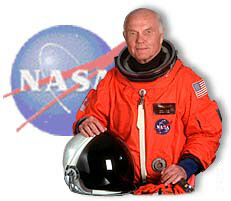
John Herschel Glenn Jr. |
The John H. Glenn Research Center at Lewis Field, formerly known as the Lewis Research Center, was founded in 1941.
Today the center is named for space pioneer John Glenn who made history in 1962 when he strapped himself into a nine-by-seven-foot capsule atop an experimental rocket and became the first American to orbit the Earth. He traveled back to space on October 29, 1998, aboard space shuttle Discovery. Between his flights, John Glenn became a U.S. Senator from Ohio.
Since 1941, researchers at the NASA center at Lewis Field have been pioneers and innovators who have expanded horizons and opened frontiers for explorers in air and space. The NASA Glenn Research Center (GRC) defines and develops propulsion, electrical power, and communications technologies for NASA's aeronautics and space missions.
- GRC is NASA's main center for research, technology and development of aircraft propulsion, space propulsion, space power and satellite communications.
- GRC oversees the Advanced Communications Technology Satellite through its master control station.
- GRC handles propulsion technology development for NASA's High Speed Research Program.
- GRC's Microgravity Science Division -- formerly known as the Microgravity Materials Science Laboratory -- specializes in microgravity experiments in combustion and fluid physics as well as measurement and analysis of the microgravity environment.
- GRC manages NASA's Atlas and Centaur launch activities.
Glenn Research Center is a critical part of Ohio’s economy with a total economic impact of more than $1 billion annually and total employment impact of more than 12,000 jobs. GRC plays leadership roles in microgravity, in-space propulsion, aerospace communications and biotechnology. The Center has contributed to many technological advances, such as a permanently implantable blood pump system that has the potential to save the lives of thousands of people waiting for heart transplants and technology that allows doctors to send high-resolution mammography images directly to medical experts anywhere in the world. Future technologies include alerts for drivers in danger of crashing and fuel cell technology that would decrease our dependence on oil imports.
The center is involved in:
- International Space Station utilization and experiments in fluid physics and combustion
- Third Generation Space Transportation including technologies for air-breathing space transportation
- Polymer Energy Rechargeable Systems developing a long-life, environmentally friendly polymer battery
- Flywheel Energy Storage System creating a longer life, lower weight and higher efficiency battery for spacecraft
- Ultra Efficient Engine Technology work toward improving engine efficiency
- Glennan Microsystems Initiative technology transfer and job creation partnership between government-university-industry
- Aerospace Education Center focusing on educating children, teachers and the public
- Medical Devices from Space Technology and Research for biomedical monitoring, sensing and analysis of human health
- Quiet Aircraft Technology Program reducing aircraft engine noise
Learn more about the NASA centers:
- NASA Headquarters Washington, D.C.
- Ames Research Center Moffett Field, California, south San Francisco Bay area
- Dryden Flight Research Center Edwards Air Force Base, California, north of Los Angeles
- Glenn Research Center Lewis Field, Cleveland, Ohio
- Goddard Space Flight Center Greenbelt, Maryland, east of Washington, D.C.
- Jet Propulsion Laboratory Pasadena, California, near Los Angeles
- Johnson Space Center Houston, Texas
- Kennedy Space Center Cape Canaveral, Florida, east of Orlando
- Langley Research Center Hampton, Virginia
- Marshall Space Flight Center Huntsville, Alabama
- Stennis Space Center Bay St. Louis, Mississippi
- Wallops Flight Facility Wallops Island, Virginia, on Virginia's Eastern Shore
| Spaceports | Rockets | Search STO | STO Cover | Feedback | Questions | © 2003 Space Today Online |